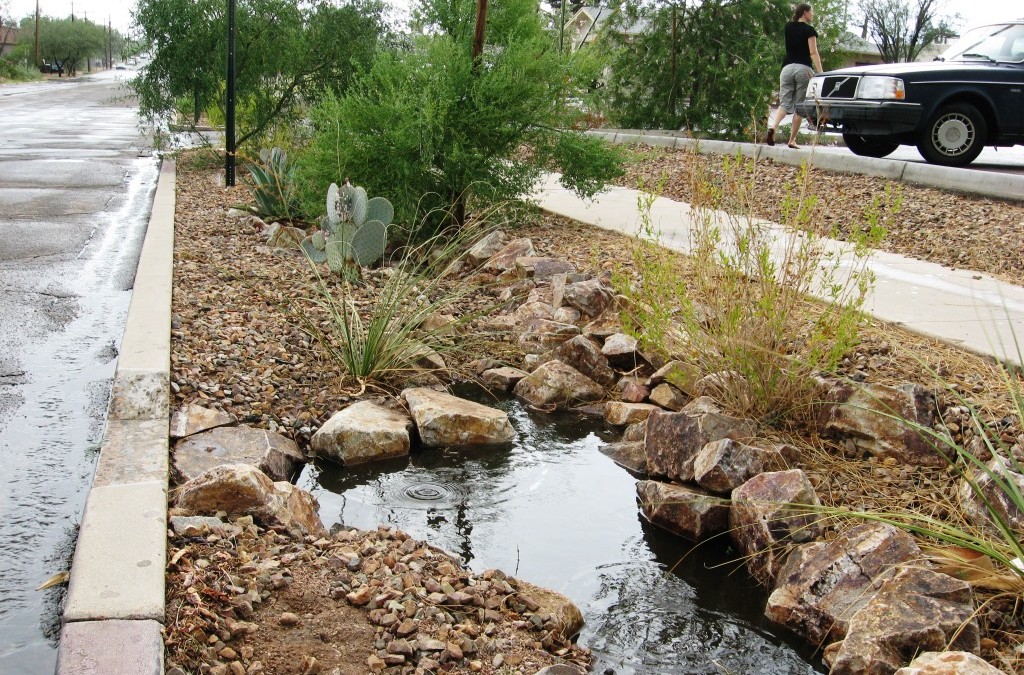Photo: green infrastructure on Cherry Ave., Tucson by Watershed Management Group.
The summer of 2016 is shaping up to be one of the hottest and driest on record for many regions of Canada. While this has been great for beachgoers, it poses a challenge to the health and resilience of local waterways and water supplies, highlighting the need for enhanced water management.
Occasional drought conditions are natural occurrences, but climate change and development may exacerbate the problem. As we are seeing, climate change can result in more extreme weather, including long stretches with little precipitation, punctuated by intense storms.
Traditional development approaches result in extensive hardened surfaces, which block rainwater from infiltrating into the ground and replenishing valuable groundwater stores. This groundwater is important for maintaining baseflows in our rivers and streams during periods of low precipitation.
Low impact development (LID)/ green stormwater infrastructure (GSI) approaches have been shown to capture and filter stormwater. By soaking rain into the ground where it can recharge aquifers, or harvesting it for reuse, we can make cities and agriculture more resilient to drought.
“Rainfall and stormwater are a resource to be harnessed, not a waste to be disposed of,” says Christine Zimmer of the Credit Valley Conservation Authority (CVC). CVC and partners have installed LID features at a number of locations and are actively monitoring their performance in storm and drought conditions. CVC worked with the City of Mississauga and Peel District School Board to design, install and monitor an LID bioretention practice located on Elm Drive in Mississauga.
Infiltration landscapes recreate the natural environment in urbanized areas. Native plants used in bioretention practices tolerate both drought and extreme rainfall. Higher quality topsoil absorbs and holds much more rainwater, reducing watering needs in the dry season. This applies to agriculture as well – farming methods that maintain good soil health can help fields absorb eight times more water than traditional practices. And soaking water into the ground helps aquifers maintain their levels, so more groundwater is available to be used during times of surface water shortage.
Soaking rain into the ground helps to replenish our aquifers and reduces the amount of untreated runoff entering our waterways, the source of drinking water for millions of Canadians. “Proper use of LID can offset many of the negative impacts of urban growth and development, even during periods of extreme drought,” said Zimmer.
Want to learn more about how community-based low impact development (LID)/ green stormwater infrastructure (GSI) can help to mitigate the impacts of drought? Join our webinar 1-2pm (EDT) September 28th, 2016 Weathering the drought- using green stormwater infrastructure to manage the impact of dry seasons with Catlow Shipek, Policy and Technical Director, Watershed Management Group.
This article was published in The Umbrella Stormwater Bulletin Issue 47.
By Alix Taylor, M.A., Water Programs and Communications Coordinator of Green Communities Canada
Poll
How has drought impacted your community this summer (check all that apply)?
- a) We have not experienced a drought this year (5%, 3 Votes)
- b) Visibly dry lawns and gardens (30%, 17 Votes)
- c) Community-wide reduction of non-essential water usage (14%, 8 Votes)
- d) Municipal restrictions on water usage (16%, 9 Votes)
- e) Dry residential or municipal wells (5%, 3 Votes)
- f) Local agricultural sector has experienced reduced crop yield (18%, 10 Votes)
- g) Reduction in tourism due to low water levels (0%, 0 Votes)
- h) Visible evidence of environmental impact in our community (wildfires, erosion, loss of wetlands etc.) (11%, 6 Votes)
- i) Other (2%, 1 Votes)
Total Voters: 20

